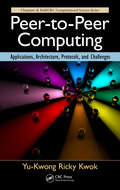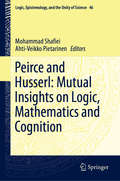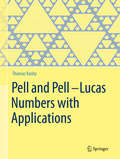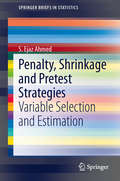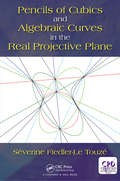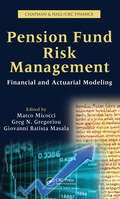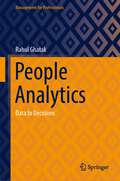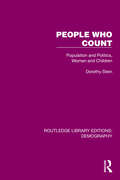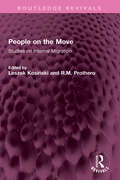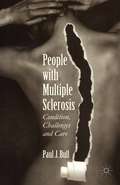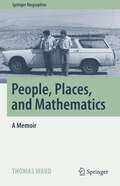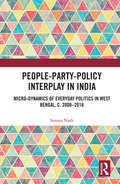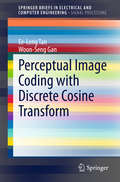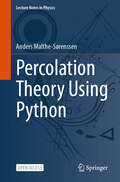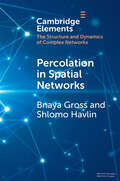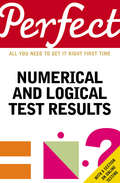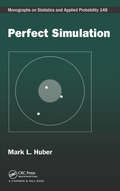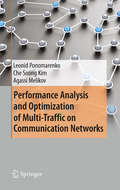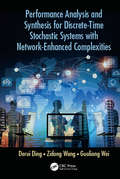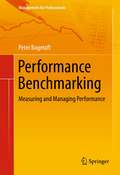- Table View
- List View
Peer-to-Peer Computing: Applications, Architecture, Protocols, and Challenges (Chapman & Hall/CRC Computational Science)
by Yu-Kwong Ricky KwokWhile people are now using peer-to-peer (P2P) applications for various processes, such as file sharing and video streaming, many research and engineering issues still need to be tackled in order to further advance P2P technologies. Peer-to-Peer Computing: Applications, Architecture, Protocols, and Challenges provides comprehensive theoretical and p
Peirce and Husserl: Mutual Insights on Logic, Mathematics and Cognition (Logic, Epistemology, and the Unity of Science #46)
by Mohammad Shafiei Ahti-Veikko PietarinenThis volume aims to provide the elements for a systematic exploration of certain fundamental notions of Peirce and Husserl in respect with foundations of science by means of drawing a parallelism between their works. Tackling a largely understudied comparison between these two contemporary philosophers, the authors highlight the significant similarities in some of their fundamental ideas. This volume consists of eleven chapters under four parts. The first part concerns methodologies and main principles of the two philosophers. An introductory chapter outlines central historical and systematical themes arising out of the recent scholarship on Peirce and Husserl. The second part is on logic, its Chapters dedicated to the topics from Peirce’s Existential Graphs and the philosophy of notation to Husserl’s notions of pure logic and transcendental logic. The third part includes contributions on philosophy of mathematics. Chapters in the final part deal with the theory of cognition, consciousness and intentionality. The closing chapter provides an extended glossary of central terms of Peirce’s theory of phaneroscopy, explaining them from the viewpoint of the theory of cognition.
Pell and Pell-Lucas Numbers with Applications
by Thomas KoshyPell and Pell-Lucas numbers, like the well-known Fibonacci and Catalan numbers, continue to intrigue the mathematical world with their beauty and applicability. They offer opportunities for experimentation, exploration, conjecture, and problem-solving techniques, connecting the fields of analysis, geometry, trigonometry, and various areas of discrete mathematics, number theory, graph theory, linear algebra, and combinatorics. Pell and Pell-Lucas numbers belong to an extended Fibonacci family as a powerful tool for extracting numerous interesting properties of a vast array of number sequences. A key feature of this work is the historical flavor that is interwoven into the extensive and in-depth coverage of the subject. An interesting array of applications to combinatorics, graph theory, geometry, and intriguing mathematical puzzles is another highlight engaging the reader. The exposition is user-friendly, yet rigorous, so that a broad audience consisting of students, math teachers and instructors, computer scientists and other professionals, along with the mathematically curious will all benefit from this book. Finally, Pell and Pell-Lucas Numbers provides enjoyment and excitement while sharpening the reader's mathematical skills involving pattern recognition, proof-and-problem-solving techniques.
Penalty, Shrinkage and Pretest Strategies
by S. Ejaz AhmedThe objective of this book is to compare the statistical properties of penalty and non-penalty estimation strategies for some popular models. Specifically, it considers the full model, submodel, penalty, pretest and shrinkage estimation techniques for three regression models before presenting the asymptotic properties of the non-penalty estimators and their asymptotic distributional efficiency comparisons. Further, the risk properties of the non-penalty estimators and penalty estimators are explored through a Monte Carlo simulation study. Showcasing examples based on real datasets, the book will be useful for students and applied researchers in a host of applied fields. The book's level of presentation and style make it accessible to a broad audience. It offers clear, succinct expositions of each estimation strategy. More importantly, it clearly describes how to use each estimation strategy for the problem at hand. The book is largely self-contained, as are the individual chapters, so that anyone interested in a particular topic or area of application may read only that specific chapter. The book is specially designed for graduate students who want to understand the foundations and concepts underlying penalty and non-penalty estimation and its applications. It is well-suited as a textbook for senior undergraduate and graduate courses surveying penalty and non-penalty estimation strategies, and can also be used as a reference book for a host of related subjects, including courses on meta-analysis. Professional statisticians will find this book to be a valuable reference work, since nearly all chapters are self-contained.
Pencils of Cubics and Algebraic Curves in the Real Projective Plane
by Séverine Fiedler - Le TouzéPencils of Cubics and Algebraic Curves in the Real Projective Plane thoroughly examines the combinatorial configurations of n generic points in RP². Especially how it is the data describing the mutual position of each point with respect to lines and conics passing through others. <P><P>The first section in this book answers questions such as, can one count the combinatorial configurations up to the action of the symmetric group? How are they pairwise connected via almost generic configurations? These questions are addressed using rational cubics and pencils of cubics for n = 6 and 7. The book’s second section deals with configurations of eight points in the convex position. Both the combinatorial configurations and combinatorial pencils are classified up to the action of the dihedral group D8. Finally, the third section contains plentiful applications and results around Hilbert’s sixteenth problem. <P><P>The author meticulously wrote this book based upon years of research devoted to the topic. The book is particularly useful for researchers and graduate students interested in topology, algebraic geometry and combinatorics. <P><P>Features: <li>Examines how the shape of pencils depends on the corresponding configurations of points <li>Includes topology of real algebraic curves <li>Contains numerous applications and results around Hilbert’s sixteenth problem <P><P>About the Author: <P><P>Séverine Fiedler-le Touzé has published several papers on this topic and has been invited to present at many conferences. She holds a Ph.D. from University Rennes1 and was a post-doc at the Mathematical Sciences Research Institute in Berkeley, California.
Pensar con modelos matemáticos: Variación lineal e inversa
by Glenda Lappan James T. Fey Susan N. Friel Elizabeth Difanis PhillipsNIMAC-sourced textbook
Pension Fund Risk Management: Financial and Actuarial Modeling (Chapman & Hall/CRC Finance Series)
by Greg N. Gregoriou Marco Micocci Giovanni Batista MasalaAs pension fund systems decrease and dependency ratios increase, risk management is becoming more complex in public and private pension plans. Pension Fund Risk Management: Financial and Actuarial Modeling sheds new light on the current state of pension fund risk management and provides new technical tools for addressing pension risk from an integr
People Analytics: Data to Decisions (Management for Professionals)
by Rahul GhatakThis book is an exploration of the people analytics possibility, bringing out both theoretical frameworks and detailed practical case studies from the author's experience in industry and business across both sides of the table, with an understanding of data science models and SMAC (Social, Mobile & Cloud) technologies underpinning it. It further explores and lays out a business case for why organizations need to invest behind this space and why HR functions and businesses need to embrace and adopt it. The book examines how people analytics makes a difference to business, describes stages of adoption and maturity models for its effective deployment in organizations and explores the journey from employee master data management and conversion to reporting and visualizations to dash-boarding and descriptive analytics, operational analytics to finally predictive modelling. The book provides insights on the impact of big data and social networks on HR and talent frameworks and the opportunity for HR to mine these networks with a view to culling out predictive insights for the business. It also describes in great detail the specific applications of people and talent analytics through case examples. The book discusses and makes the case for HR to be metric driven focused on business outcomes. It enumerates upon “lead” and “lag” indicators and the need to leverage relevant measurement systems. It provides an understanding of relevant statistical tools that could be deployed to mine key insights from the data to enable robust decision-making, and examines the power of “visual intelligence” and data representation that goes beyond traditional tools like Excel. This book is for HR practitioners who seek to challenge the status quo. It does so by helping them leverage a data and evidence based approach; asking the right questions and building new capabilities with a view towards leading change and driving transformation both in their domain, the wider business and the larger organization. The book is also useful for HRM students to gain a deep understanding of “people analytics” as a critical sub-domain within HR. “HR is not just about people but now also about Tech, Data and Analytics. Upgrading numerical/analytics skills in order to have greater impact on the business, is the new wave of HR, which Rahul helps address via his own rich experience.”- Gurprriet Siingh, Managing Director, Russell Reynolds Associates, Mumbai, India. “This book would help HR & Leadership Teams find a way of discarding perceptions and uncovering truth by embracing data patterns as opposed to just continuing with incremental changes to how it has always been. This is particularly so of successful organizations.”- Vikas Gupta, Divisional Chief Executive Officer, Education and Stationery Products Business, ITC Limited, Gurugram, India.
People Who Count: Population and Politics, Women and Children (Routledge Library Editions: Demography #12)
by Dorothy SteinOriginally published in 1995, this book confronts the contentious political issues on all sides of the population debate, including immigration, demographic competition, gender ratios, reproductive research and children’s rights. The book argues that lower fertility rates are preferred by women themselves; are beneficial in their own right to both women and children; and should not be used as a bargaining chip in any other area of the development debate. Drawing on a large body of research in anthropology, child psychology and population studies the book presents evidence that the poor do not necessarily have large families as form of financial security, or to put them to work; people without offspring are less lonely in old age; immigration and refugee controls in the Northern Hemisphere have been more driven by politics than rational calculation and human rights; social security does not require a large cohort of young workers. This book is a challenging contribution to the development debate. It presents a persuasive case for policies which recognise hopeful trends in relieving the environmental and social pressures of a globally increasing population.
People on the Move: Studies on Internal Migration (Routledge Revivals)
by R. Mansell Prothero Leszek A. KosinskiOriginally published in 1975, this volume examines conceptual and theoretical aspects of the study of internal migration, both in chapters dealing specifically with theory and data and in case studies. The book discusses the question of who migrates, and why and what are the patterns of flow and direction of movement. The consequences of migration are analysed. Migration is one of the most difficult components of population change to conceptualize and measure and this book considers a wide range of aspects of migration and the problems connected with it.
People with Multiple Sclerosis: Condition, Challenges and Care
by Paul J. BullMultiple sclerosis is an incurable neurological disease of unknown cause with a fearful reputation for generating disability, unemployment, poverty and early death. This book critically surveys the current state of multiple sclerosis research, demonstrating the shortfall of current research undertaken on the lives of people with multiple sclerosis.
People, Places, and Mathematics: A Memoir (Springer Biographies)
by Thomas WardThis memoir chronicles the journey of an academic, tracing a path from primary school in Zambia to a career in higher education as a mathematician and educational leader. Set against the backdrop of the 20th century, the book explores how early influences and historical events shape an individual's life and professional trajectory. The author shares childhood experiences across three parts of Africa, providing an original perspective as a witness to the post-colonial period. Through personal reflections, the memoir delves into the emergence of ideas and collaborations in mathematics and how these shape career choices. It also offers candid observations on the major changes in British higher education since the 1980s. Intended for a general audience, this book provides a compelling read for anyone interested in the experience of becoming a mathematician, and higher education in general.
People-Party-Policy Interplay in India: Micro-dynamics of Everyday Politics in West Bengal, c. 2008 – 2016
by Suman NathThis book analyses the political transition in West Bengal, India, which witnessed longest democratically elected Left regime of the world. It examines and compares micro-dynamics of political practices in India and delineates underlying political themes of state politics. The author explores the politics of land reform and the anti-land-acquisition movements which were critical points in the contemporary history of Bengal in independent India. The volume further delves into the caste and communal politics which had been latent until the Left Front’s loss in the state, as well as the what sets apart politics in West Bengal from other Indian states. Based on thorough ethnographic research, this volume will be of great interest to scholars and researchers of South Asian studies, politics and political processes, sociology and social anthropology.
Perception of Family and Work in Low-Fertility East Asia (SpringerBriefs in Population Studies)
by Junji Kageyama Eriko TeramuraThis book is the first of its kind to incorporate subjective well-being (SWB) data to comprehensively explore perceptional factors that relate to fertility behavior in East Asia. The advantage of SWB data lies in the accessibility to rich information regarding perceptions, attitudes, and behaviors. With this advantage, the book inquires into the perceptions toward family and work and explores the attitudes that lead to low fertility in the region.To this end, first a comparative analysis with international cross-sectional data is performed and the East Asian characteristics of family and work perceptions are documented. Then, three democracies in the region are focused on—Japan, South Korea, and Taiwan—to investigate the relationships between cultural orientations, work–life balance, and fertility outcomes with panel data. In addition, East Asian results are compared with those in India, which has also been experiencing a rapid transition from a traditional society to an industrial one. The results support the idea that the friction between persistent gender-based role divisions and socioeconomic transformation in East Asia makes it difficult for women to balance family and work, prompting fertility decline to the lowest-low level in the region.
Perceptual Image Coding with Discrete Cosine Transform
by Ee-Leng Tan Woon-Seng GanThis book first introduces classic as well as recent computational models for just-noticeable-difference (JND) applications. Since the discrete cosine transform (DCT) is applied in many image and video standards (JPEG, MPEG-1/2/4, H. 261/3), the book also includes a comprehensive survey of computational models for JND that are based on DCT. The visual factors used in these computational models are reviewed in detail. Further, an extensive comparative analysis of these models using quantitative and qualitative performance criteria is presented, which compares the noise shaping performance of these models with subjective evaluation and the accuracy between the estimated JND thresholds and subjective evaluation. There are many surveys available on computational models for JND; however, these surveys seldom compare the performance of computational models that are based on DCT. The authors' survey of the computational models and their in-depth review of the visual factors used in them will help readers understand perceptual image coding based on DCT. The book also provides a comparative analysis of several perceptual image coders that are based on DCT, which are compatible with the highly popular and widely adopted JPEG standard.
Percolation Theory Using Python (Lecture Notes in Physics #1029)
by Anders Malthe-SørenssenThis course-based open access textbook delves into percolation theory, examining the physical properties of random media—materials characterized by varying sizes of holes and pores. The focus is on both the mathematical foundations and the computational and statistical methods used in this field. Designed as a practical introduction, the book places particular emphasis on providing a comprehensive set of computational tools necessary for studying percolation theory. Readers will learn how to generate, analyze, and comprehend data and models, with detailed theoretical discussions complemented by accessible computer codes. The book's structure ensures a complete exploration of worked examples, encompassing theory, modeling, implementation, analysis, and the resulting connections between theory and analysis. Beginning with a simplified model system—a model porous medium—whose mathematical theory is well-established, the book subsequently applies the same framework to realistic random systems. Key topics covered include one- and infinite-dimensional percolation, clusters, scaling theory, diffusion in disordered media, and dynamic processes. Aimed at graduate students and researchers, this textbook serves as a foundational resource for understanding essential concepts in modern statistical physics, such as disorder, scaling, and fractal geometry.
Percolation in Spatial Networks: Spatial Network Models Beyond Nearest Neighbours Structures (Elements in Structure and Dynamics of Complex Networks)
by Shlomo Havlin Bnaya GrossPercolation theory is a well studied process utilized by networks theory to understand the resilience of networks under random or targeted attacks. Despite their importance, spatial networks have been less studied under the percolation process compared to the extensively studied non-spatial networks. In this Element, the authors will discuss the developments and challenges in the study of percolation in spatial networks ranging from the classical nearest neighbors lattice structures, through more generalized spatial structures such as networks with a distribution of edge lengths or community structure, and up to spatial networks of networks.
Perfect Numerical and Logical Test Results
by Joanna Moutafi Marianna Moutafi-Have you been asked to sit a numerical or logical reasoning test?-Do you need some help preparing for the questions you'll be asked?-Do you want to make sure you perform to the best of your abilities?Perfect Numerical and Logical Test Results is an essential guide for anyone who wants to secure their ideal job. Written by two experts in occupational and clinical psychology, it explains how numerical and logical tests work, gives helpful pointers to help you prepare for the big day, and provides professionally constructed sample questions so that you can practise at home. It also contains an in-depth section on online testing - the route that more and more recruiters are choosing to take. Whether you're a graduate looking to take the first step on the career ladder, or you're planning an all-important job change, Perfect Numerical and Logical Test Results has everything you need to make sure you stand out from the competition.The Perfect series is a range of practical guides that give clear and straightforward advice on everything from getting your first job to choosing your baby's name. Written by experienced authors offering tried-and-tested tips, each book contains all you need to get it right first time.
Perfect Powers—An Ode to Erdős (Infosys Science Foundation Series)
by Saradha NatarajanThe book explores and investigates a long-standing mathematical question whether a product of two or more positive integers in an arithmetic progression can be a square or a higher power. It investigates, more broadly, if a product of two or more positive integers in an arithmetic progression can be a square or a higher power. This seemingly simple question encompasses a wealth of mathematical theory that has intrigued mathematicians for centuries. Notably, Fermat stated that four squares cannot be in arithmetic progression. Euler expanded on this by proving that the product of four terms in an arithmetic progression cannot be a square. In 1724, Goldbach demonstrated that the product of three consecutive positive integers is never square, and Oblath extended this result in 1933 to five consecutive positive integers. The book addresses a conjecture of Erdős involving the corresponding exponential Diophantine equation and discusses various number theory methods used to approach a partial solution to this conjecture. This book discusses diverse ideas and techniques developed to tackle this intriguing problem. It begins with a discussion of a 1939 result by Erdős and Rigge, who independently proved that the product of two or more consecutive positive integers is never a square. Despite extensive efforts by numerous mathematicians and the application of advanced techniques, Erdős' conjecture remains unsolved. This book compiles many methods and results, providing readers with a comprehensive resource to inspire future research and potential solutions. Beyond presenting proofs of significant theorems, the book illustrates the methodologies and their limitations, offering a deep understanding of the complexities involved in this mathematical challenge.
Perfect Rigor: A Genius and the Mathematical Breakthrough of the Century
by Masha GessenA gripping and tragic tale that sheds rare light on the unique burden of genius In 2006, an eccentric Russian mathematician named Grigori Perelman solved the Poincare Conjecture, an extremely complex topological problem that had eluded the best minds for over a century. A prize of one million dollars was offered to anyone who could unravel it, but Perelman declined the winnings, and in doing so inspired journalist Masha Gessen to tell his story. Drawing on interviews with Perelman's teachers, classmates, coaches, teammates, and colleagues in Russia and the United States--and informed by her own background as a math whiz raised in Russia--Gessen uncovered a mind of unrivaled computational power, one that enabled Perelman to pursue mathematical concepts to their logical (sometimes distant) end. But she also discovered that this very strength turned out to be Perelman's undoing and the reason for his withdrawal, first from the world of mathematics and then, increasingly, from the world in general.
Perfect Simulation
by Mark L. HuberExact sampling, specifically coupling from the past (CFTP), allows users to sample exactly from the stationary distribution of a Markov chain. During its nearly 20 years of existence, exact sampling has evolved into perfect simulation, which enables high-dimensional simulation from interacting distributions.Perfect Simulation illustrates the applic
Perfectoid Spaces: Lectures From The 2017 Arizona Winter School (Infosys Science Foundation Series #242)
by Debargha Banerjee Kiran S. Kedlaya Ehud De Shalit Chitrabhanu ChaudhuriThis book contains selected chapters on perfectoid spaces, their introduction and applications, as invented by Peter Scholze in his Fields Medal winning work. These contributions are presented at the conference on “Perfectoid Spaces” held at the International Centre for Theoretical Sciences, Bengaluru, India, from 9–20 September 2019. The objective of the book is to give an advanced introduction to Scholze’s theory and understand the relation between perfectoid spaces and some aspects of arithmetic of modular (or, more generally, automorphic) forms such as representations mod p, lifting of modular forms, completed cohomology, local Langlands program, and special values of L-functions. All chapters are contributed by experts in the area of arithmetic geometry that will facilitate future research in the direction.
Performance Analysis and Optimization of Multi-Traffic on Communication Networks
by Leonid Ponomarenko Agassi Melikov Che Soong KimPromptly growing demand for telecommunication services and information interchange has led to the fact that communication became one of the most dynamical branches of an infrastructure of a modern society. The book introduces to the bases of classical MDP theory; problems of a finding optimal САС in models are investigated and various problems of improvement of characteristics of traditional and multimedia wireless communication networks are considered together with both classical and new methods of theory MDP which allow defining optimal strategy of access in teletraffic systems. The book will be useful to specialists in the field of telecommunication systems and also to students and post-graduate students of corresponding specialties.
Performance Analysis and Synthesis for Discrete-Time Stochastic Systems with Network-Enhanced Complexities
by Zidong Wang Derui Ding Guoliang WeiThe book addresses the system performance with a focus on the network-enhanced complexities and developing the engineering-oriented design framework of controllers and filters with potential applications in system sciences, control engineering and signal processing areas. Therefore, it provides a unified treatment on the analysis and synthesis for discrete-time stochastic systems with guarantee of certain performances against network-enhanced complexities with applications in sensor networks and mobile robotics. Such a result will be of great importance in the development of novel control and filtering theories including industrial impact. <P><P>Key Features <li>Provides original methodologies and emerging concepts to deal with latest issues in the control and filtering with an emphasis on a variety of network-enhanced complexities <li>Gives results of stochastic control and filtering distributed control and filtering, and security control of complex networked systems <li>Captures the essence of performance analysis and synthesis for stochastic control and filtering <li>Concepts and performance indexes proposed reflect the requirements of engineering practice <li>Methodologies developed in this book include backward recursive Riccati difference equation approach and the discrete-time version of input-to-state stability in probability
Performance Benchmarking
by Peter Bogetoft"In this book, Peter Bogetoft - THE expert on the theory and practice of benchmarking - provides an in-depth yet very accessible and readable explanation of the best way to do benchmarking, starting from the ground up." Rick Antle William S. Beinecke Professor of Accounting, Yale School of Management CFO, Compensation Valuation, Inc. "I highly recommend this well-written and comprehensive book on measuring and managing performance. Dr. Bogetoft summarizes the fundamental mathematical concepts in an elegant, intuitive, and understandable way." Jon A. Chilingerian Professor, Brandeis University and INSEAD "Bogetoft gives in his book Performance Benchmarking an excellent introduction to the methodological basis of benchmarking." Christian Parbøl Director, DONG Energy "This book is the primer on benchmarking for performance management." Albert Birck Business Performance Manager, Maersk Oil "This excellent book provides a non technical introduction for performance management." Misja Mikkers, Director, Dutch Health Care Authority "With this very well written and comprehensive introduction to the many facets of benchmarking in hand, organizations have no excuse for not applying the best and cost effective benchmarking methods in their performance assessments." Stig P. Christensen Senior R&D Director, COWI
